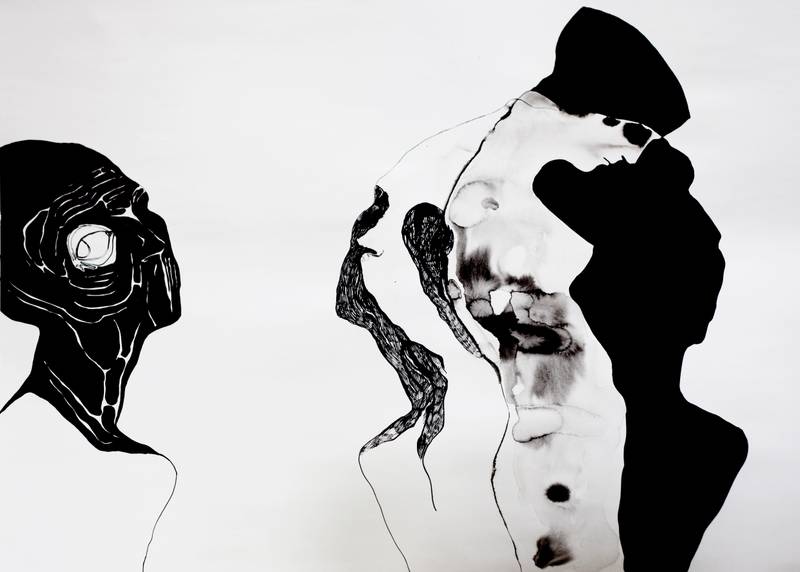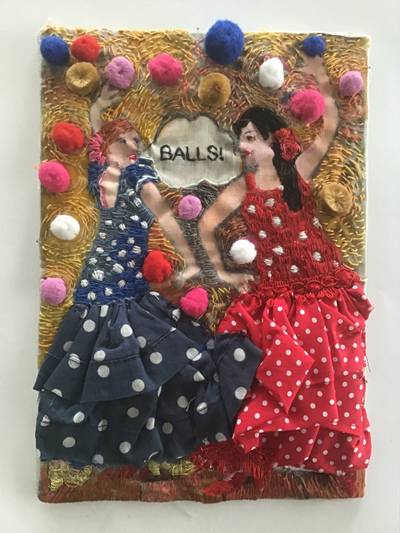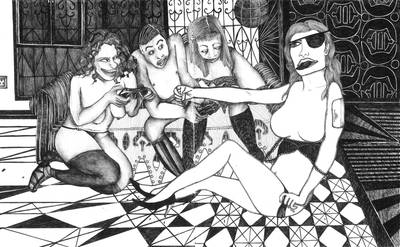

Elham Rahmati, Not only will I stare, I want my look to change reality
Elham Rahmati (b. 1989, Tehran) is a visual artist and curator based in Helsinki. She is the co-founder and co-editor of NO NIIN. In 2019 and 2020, she worked as the curator and producer of the Academy of Moving People & Images (AMPI), a film school in Helsinki for mobile people.
Vidha Saumya (b. 1984, Patna) is a Helsinki-based artist-poet. She is the co-founder and co-editor of NO NIIN – an online monthly magazine in Finland, and a founding member of the Museum of Impossible Forms – an award-winning cultural para-institution in Kontula, Finland.
So many dreams, so little imagination
Elham Rahmati
Recently, I was in a panel discussion with ideas in the air regarding film and representation. All was good and carefully put together. I’m not a fan of panel discussions, mainly because I have difficulty concentrating and spend the entire time daydreaming, while staring at the panelists. That is, unless the panelists are my friends; in which case, I beat myself repeatedly to make sure I remain mentally present, which is what I did on this particular panel. In the Q & A afterwards, I brought up a question that had been bugging me for a while, regarding film festivals, and the relatively new trend of introducing an award/grant category dedicated to BIPOC creatives. At first glance, it is exciting, that instant feeling of being acknowledged and heard. Some may call it a step forward, but it’s one of those pieces of good news that has an aftertaste that you are not quite sure how you feel about. I had been asking myself if the winners of this particular category get nearly as much attention and resources as the winners of the main category awards, such as best motion picture or best director? BIPOC creatives spot breadcrumbing from miles away and to me, this trend comes off as one. But since I hadn’t made up my mind about it, I brought it up as a question as I am genuinely interested in listening to other opinions. After all, I believe one should be extra cautious not to let one’s trauma projections rob themselves and others of the joy they could otherwise experience. So I asked, “Is this good news or is this breadcrumbing that delays us pushing and asking for more?” I received different responses from the room, more or less indicating that it is either this or nothing and that we should take these opportunities but not be content with them and keep pushing for more. They also reminded me that technically, BIPOC filmmakers are not excluded from entering the main competition in festivals, so the door is always open for them to be part of the main competition. I took these responses as they were, nodded off and we moved on to other questions.
Later, I wondered to myself, what do we mean by saying that no one is excluded from the main competition and it is free for all to enter? Aren’t we then ignoring the structural barriers that exist from the ground up, stopping us from seamlessly passing through the gates that enable us to enter the main competition? The fact that there is no outright ban doesn’t indicate that this is a fair fight. It never is.
In Finland, the private Aalto University, and Metropolia University of applied sciences in Helsinki host the main university-based film schools in the country. The Department of Film, Television and Scenography within the School of Arts, Design and Architecture has its origins in the former industrial art school, the latter having been integrated into Aalto University in 2010. “The education on offer at Aalto remains quite exclusive: out of 457 applicants for the different film programs in the 2014 round, only 18 students were accepted in total, across all the different specializations.1” This number has not changed much in recent years.
I remember once in a meeting with the Head of the Department of Film, Television and Scenography at Aalto University, she expressed her frustration with the applications they were receiving at Aalto University and the fact that “the majority of applicants are white and from upper middle class “artist” families and that not many interesting stories can come from their rather limited, comfortable and privileged backgrounds”. When I inquired about the reason, one speculation was that the educational consultants whose job is to advise students on which major to pursue for higher education rarely ever recommend creative majors such as visual arts, film or theatre to the BIPOC students or the students coming from working class families. These students also have a lower chance of receiving such encouragement from their families, not because their families don’t value art and culture, but simply because they can’t afford to support their children living a life of precarity in the arts. What are the chances that their kid ends up being one of the chosen few?
A few months ago, I came across this information in a call for papers for a special issue of the Journal of Scandinavian Cinema focused on race and ethnicity in Nordic film cultures, which I find relevant to this conversation:
“In 2017, the head of the Swedish Film Institute (SFI), Anna Serner, highlighted the distinct lack of ethnic diversity in Swedish film culture and signalled ambitions to ‘broaden representation, both behind and in front of the cameras’ (2017: 4). Echoing these sentiments, the Danish Film Institute (DFI) and the Norwegian Ministry of Culture (NFI) have outlined targets for ‘increasing cultural diversity and reaching new audiences’ (NFI 2018). These statements reflect the Nordic film industries’ aspiration to address the significant underrepresentation of black, Asian and minority ethnic voices in the creative sectors across the Nordic region. However, themes of race and ethnicity have long-established patterns of representation on Nordic screens (see Wright, 1998, Gustafsson, 2014 and Sundholm, 2018). With no established industry voice or body overseeing representational diversity, as the above studies attest, cinematic depictions of diversity matter precisely because they largely offer the only insight into the way these themes are understood and construed. Overwhelmingly, white filmmakers produce these examples and, as a result, many offer self-critical introspective forms of whiteness. While most are well meaning, often they reflect a liberal perspective that is symptomatic of institutionalised notions of inequality within Nordic media cultures. First and second-generation filmmakers like Hella Joof, Josef Fares, Omar Shargawi and Ali Abbasi have made headway into challenging these ideas by producing films that highlight more complex and diverse perspectives on Nordic societies, but they have received little scholarly attention.”2
This new category that is supposed to make me happy tells me one thing: it says: "hey, we hear you and we feel for you but at the moment it is not feasible for us to make any systematic changes in order to ensure equity for all. But here, take this bandaid and put it on your wound so you don’t bleed all over the freshly cut grass of my lawn.‘’ And you think to yourself, ‘ok, at least they’ve heard me, they put one step forward, another step will follow soon’. But will it? How long will it take? How much more should we fake it in order to make it? I’ll give you a hint: Someone once told me last year that the first objections to the Kiasma staff being made up of entirely white-Finnish professionals happened more than a decade ago. It took Kiasma around 15 years to hire one non-Finnish curator (who is a European male curator by the way, so not too far out of their comfort zone, one might say). If this tiny little step took 15 years, imagine how many years we have to wait for a non-cis male, black/ indiginious/ person of color, who doesn’t cherish and implement neoliberal values and policies, to get a leadership position there. Will it even happen in our lifetime?
The problem with the awards and grants that claim to promote diversity, in my opinion, is that they are mainly engineered to let only a few people in. Those people become the shining stars that have to carry the burden of being an outspoken advocate on behalf of all their communities. A work so loaded that many break under it. Not everyone wants to be an advocate, not everyone wants to be a representative of their race, gender, sexual orientation, etc. Even if they want to take on that role, it still wouldn’t make things fair. Putting a spotlight on a few people robs others of rays that can equally brighten up their day. This is a system that might do good in the short term, but in the long run, it fosters resentment, competition, hatred and loneliness within members of the same marginalised communities. It is the same old divide and conquer tactic.
I fully understand and empathise with the point of view that believes we should accept these steps as tokens of good intention and visible change. BUT I just want to put this out there, “What if we don’t?” What if we started imagining principles and actions that would level the field for us from the ground up? What would that world look like?
We must persist in dreaming, but not dreams so devoid of imagination and boring that they beg you to wake yourself up. We are artists, not neoliberal politicians. So, how about we leave them and their dried up and self-serving visions and build our own dreams in which we are the main star and not their supporting best friend?
Scrolling through my IG reels, I came across a video of a dating coach saying this:
“You see, when you are starving for love, the breadcrumbs of attention that every motherfucker presents to you start looking tasty. You don’t deserve breadcrumbs, you deserve the entire bakery!”
I could not agree more.
I’m going to smoke a cigarette
I’m going to cook rice
Vidha Saumya
there are so many perfect people
those, who are, the right hue of radical and philosophical
like bird shit, they drop on me and make my day
help me sway the right way
on how to ignore and deem irrelevant
that which is not my own
unsolicitedly, they let me know,
‘those immigrant brown women, filling up spaces with their faces and bodies and their ideas!’
ideas that they nourish and cherish and that which they call their own
so what?
let’s disown
them
let’s push
them
into isolation and oblivion
let them not shine
if they shine, they'll shed
light
on the fault lines
on the prejudices
that run deeper than Helsinki metro lines
these brown women,
who do they think they are; sharing platforms
who told them, we want to stand by their side,
share
a ride with them?
so naive.
them
sigh!
my oh my oh my
so sweet and cute
wearing lipstick in broad daylight
pining for matching shoes
and worldly delights
why must they have them?
why can’t they lead by trauma?
why can’t they call themselves
the forgotten and marginalized,
why can’t they play
the minoritisation game
just right?
why must they not be desperate for us,
languish
at our lack of respect for them,
and wither
to our might?
my word! just look at them,
unafraid
unfazed,
with no safety nets of health,
unemployment benefits
residence permits,
and housing relief,
where do they think they are?
this is not their space,
not their fight
how dare they bring delight!
let’s snub them a little
tell them it’s a foreign scene
let’s pile our frustrations on them, with ease
my goodness, don’t bother
with how it makes *them* feel
they’re brown women
they’re born with thick skins
let’s not give
them
a chance for a conversation
let’s bully
them
to no respite
cancel them
ignore them
for sure they can’t put up
a fight
they think they know it all
let’s burn their bridges
gosh! they can’t even fight
let’s fatigue
them
with accusations
and academic fright.
well well well, better still
let us work with their oppressor
that harasser
one of a kind,
devouring ideas and people
let’s support them, be on their side
jeez, these women
not worthy of love
want to criss-cross
at its cusp
let’s show
them
how it’s done
first root for, then shun
before they even speak
let’s correct their English
their politics
let's crush their pride
and their delusion of being majestic
let’s frown on
them
spread rumours of their intent
blindside
them
with our vent,
they won’t know what’s coming at them,
Nah, they don’t deserve that
there was once…
once every week
a seminar on care work
and how it should be intersectional,
those brown women were like, “oh wow! what a great time to be alive, right?”
turns out the intersection never crossed
the brown women’s quarters
hit truth, between the eyes
for they must be the extenders of care
not the receivers, how they dare!
their pleasure revolution is just too much
stepping out of boxes, having too much fun
like what are they even thinking,
why aren’t they just zoned out and pissed?
why aren’t they wobbly with admin tasks
why do they not wear a hypocrite mask?
so incompatible, so crunchy and loud
what’s with all the colours and emotional cloud
why can’t they repeat just what we’re used to
why do they stir the spoons so noisily
fishing change in a flat scene
what do they wish to accomplish
why aren’t they happy being a panellist?
and writing a poem or two
if cliches work, why can't they
9-5 all weekdays
they should be half as interesting than they can be
who’s got the bandwidth
for surprising spree
they may have lots to say
don’t they know we’re be-zay
galloping on our moral high horses
speaking on empathy discourses
their solidarity has no fizz
it’s not even popular
it may even be a myth
boooo! see!
them passing
how shamelessly they glee
in their miraculous brown skin
and heartburns of third-degree
bursting with pride
strutting their glare
as if they can’t be refused
as if someone really cares
gosh! can’t bear to see
them
and their shuddering commotion
provoking new paths like party decoration
let them wallow at the mystery of the rumours
let their misery turn into imbecile tumours
ugh!! what’s this “doing things right” nonsense
bringing imagination and doubt to our perfect conscience
pfft!
their golden dust of charisma,
their taking space ease
it’s getting too much, please!
why let them be?
let’s prescribe verses in righteousness
ask for their credibility
they’re mixing it all up, making it wet
automatically, without regret
why aren’t they discouraged?
they’ve even written openly
about what brings them unrest
why are they happy?
why can’t they be snappy?
flip at our word-mince
flap their immigrant-wings
at our mouth-freshening judge-mints
the brown women
looked up, befuddled.
must we continue doing this?
net-lifting every blow?
or should we shoulder instead
each other’s politicality?
centre pleasure,
read love poetry
said the brown woman, to another,
since we have some understanding
and we too can grin
let’s take it on the chin
because at the various cusps
well also find smirks
belittling
unsettling
questioning
diminishing returns
between utility and profit
between welfare and repair
there will be despair
but do we have time to spare?
“have you sent the December contracts?”
“yes, I have. will you sign them when you have time?”
“could you check that email, I wrote”
“Checked, added a sentence”
I’m going to smoke a cigarette
I’m going to cook rice






